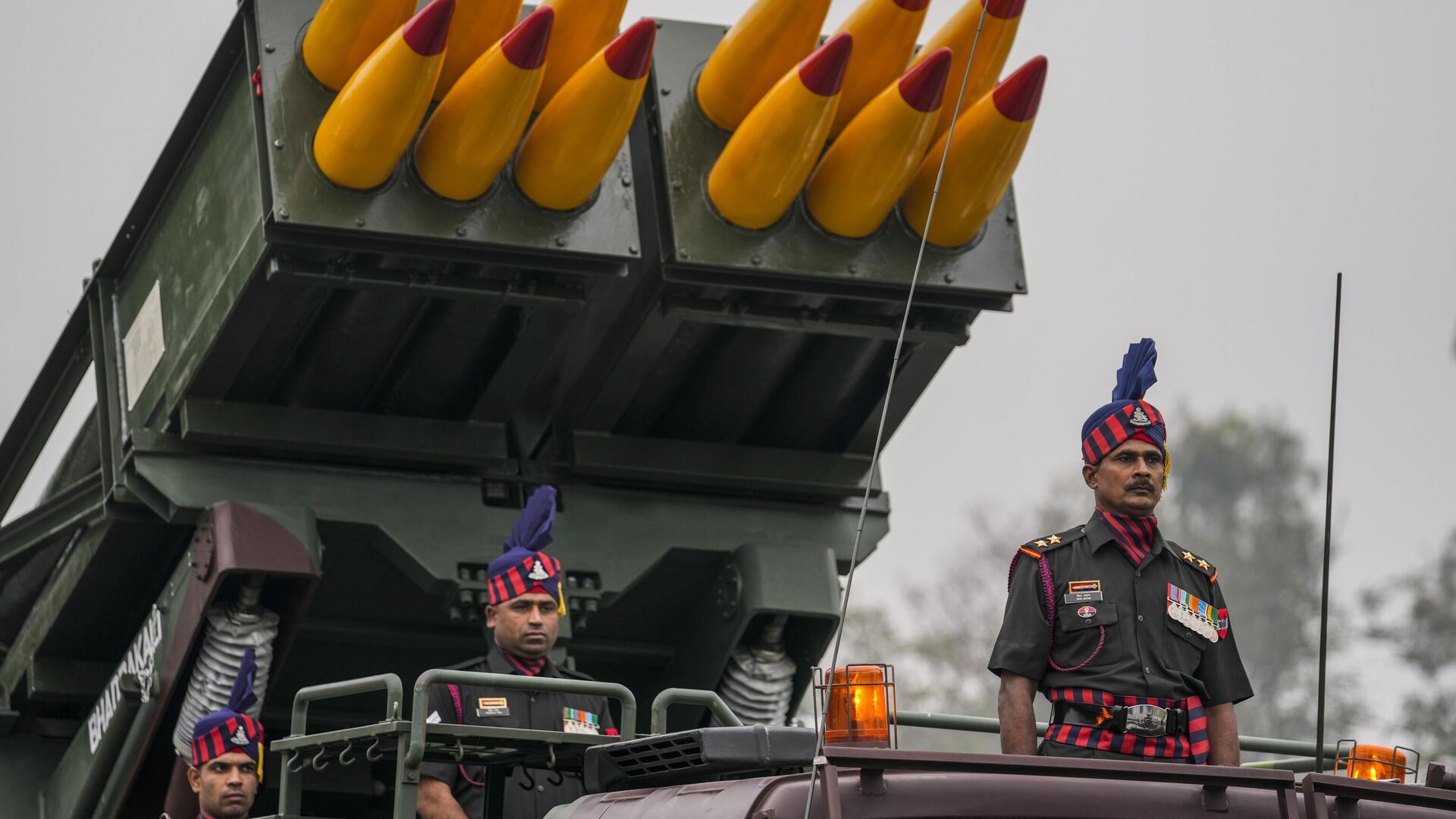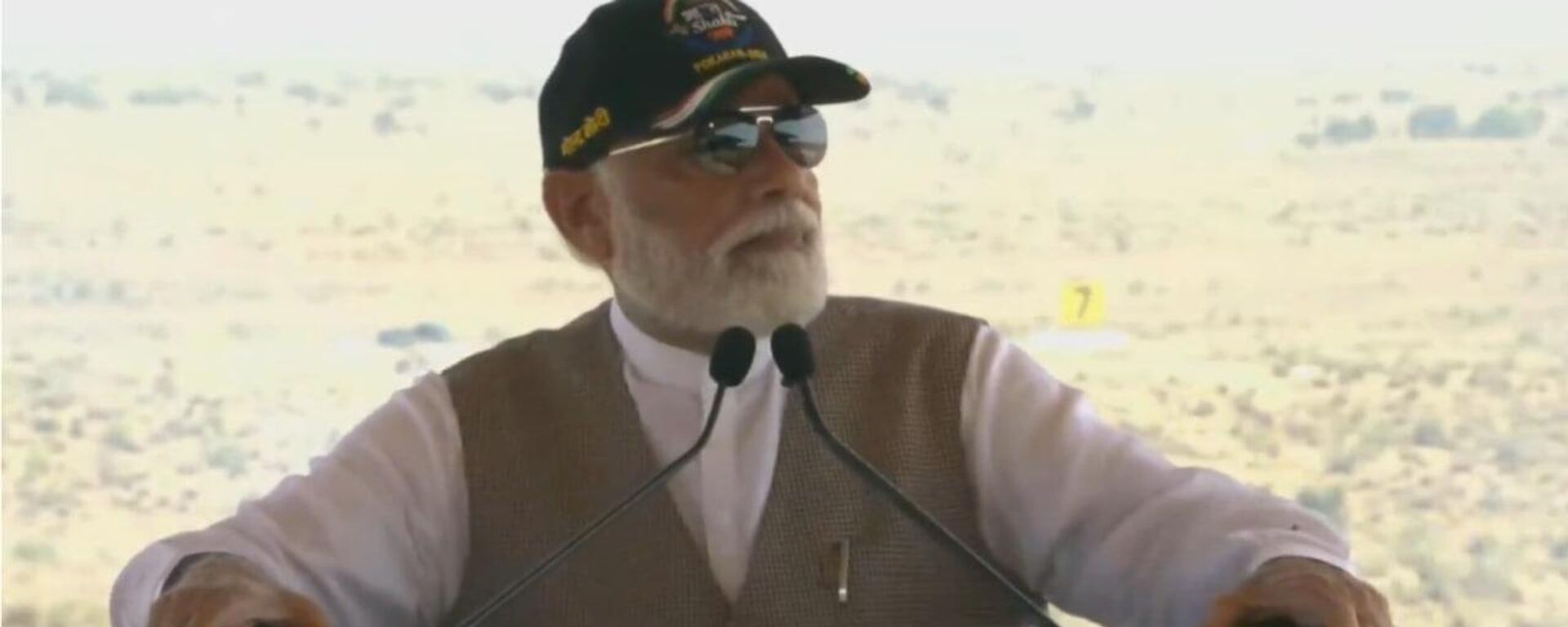https://sputniknews.in/20240314/indias-long-delayed-integrated-battle-groups-finally-come-of-age-6826898.html
India's Long-Delayed Integrated Battle Groups Finally Come of Age
India's Long-Delayed Integrated Battle Groups Finally Come of Age
Sputnik India
The 'Bharat Shakti (Indian Power)' drills conducted by the Indian tri-service in the desert terrain of Pokharan near the border with Pakistan has been one of the strongest displays of the prowess of the Integrated Battle Groups
2024-03-14T15:22+0530
2024-03-14T15:22+0530
2024-03-14T15:22+0530
defenсe news
india
new delhi
pakistan
indian air force (iaf)
ministry of defence (mod)
narendra modi
unmanned aerial vehicles (uavs)
drone
reconnaissance drone
https://cdn1.img.sputniknews.in/img/07e7/0b/12/5467504_0:285:3073:2014_1920x0_80_0_0_1ea74dedb78453c552bc457b3ae85e1c.jpg
The 'Bharat Shakti (Indian Power)' drills conducted by the Indian tri-service - Army, Indian Air Force (IAF) and Indian Navy - in the desert terrain of Pokharan near the border with Pakistan has been one of the strongest displays of the prowess of the newly-constituted Integrated Battle Groups (IBGs), according to military veterans.The stated objective of the tri-service drills was to showcase the "strength of India's domestic defence capabilities on the global stage", in line with Prime Minister Narendra Modi's Atmanirbhar Bharat (Self-reliant India) policy push. The large-scale drills saw the participation of From the IAF, the drills saw the participation of The Navy also showcased its anti-ship missiles and autonomous cargo carrying aerial vehicles among others at the desert war games.Concept of IBGs Clearly Visible in Bharat Shakti Drills: Army VetMajor General (retired) Harsha Kakar, an Indian Army veteran who has also previously served as the departmental head of India's tri-service training institute College of Defence Management (CDM) told Sputnik India that Indian forces clearly demonstrated their IBG capabilities during the tri-service drills.He noted that importantly, the drills also provided a display of capabilities of India's indigenously-built systems.The veteran cited the remarks by India's first Chief of Defence Staff (CDS), the late General Bipin Rawat, who had stated that India would fight its next war using its own equipment.Benefits of Having IBGsNew Delhi has mulled the idea of re-organising its forces along the western frontier into IBGs for swifter and effective deployment in case of a contingency at least since 2001, when the Indian Parliament faced a terrorist attack carried out by banned groups Jaish-e-Mohammad (JeM)* and Lashkar-e-Tayyiba (LeT)**.The IBGs are viewed as part of New Delhi's 'Cold Start' doctrine, which reportedly aims at carrying out a swifter response to a military contingency at the western border.In response to the terrorist attacks, India ordered a massive mobilisation of thousands of its troops along the western frontier with Pakistan, in what was called 'Operation Parakram (attack)'. However, there was criticism in military circles due to the delayed mobilisation process, necessitating a re-think in the military deployment policy.Reports quoting unnamed defence officials in 2021 suggested that Indian forces gave "final touches" to the IBGs, each of them having a troop strength of around 5,000, and began deploying them along the western and eastern borders."Having multiple formations, with each one working independently, coordinating among them and then bringing them on the battlefield has proven to be a rather herculean task, as proven by past experiences of mobilisation, which have been rather slow and cumbersome. The process eats into a lot of crucial time during crisis situations. The Air Force takes around a couple of days, while the Army takes a longer time," Matheswaran explained.He said that most of the other major forces had transitioned or were already experimenting with the concept of IBGs.*banned terrorist group in India**banned terrorist group in India
https://sputniknews.in/20240312/modi-reiterates-self-reliance-focus-as-indian-pm-witnesses-tri-service-exercise-in-rajasthan-6812110.html
india
new delhi
pakistan
rajasthan
line of control (loc)
china
line of actual control (lac)
russia
Sputnik India
feedback.hindi@sputniknews.com
+74956456601
MIA „Rossiya Segodnya“
2024
Dhairya Maheshwari
https://cdn1.img.sputniknews.in/img/07e6/0c/13/138962_0:0:641:640_100x100_80_0_0_2cb44360dbcdf6d84bf4b299cd045917.jpg
Dhairya Maheshwari
https://cdn1.img.sputniknews.in/img/07e6/0c/13/138962_0:0:641:640_100x100_80_0_0_2cb44360dbcdf6d84bf4b299cd045917.jpg
News
en_IN
Sputnik India
feedback.hindi@sputniknews.com
+74956456601
MIA „Rossiya Segodnya“
Sputnik India
feedback.hindi@sputniknews.com
+74956456601
MIA „Rossiya Segodnya“
Dhairya Maheshwari
https://cdn1.img.sputniknews.in/img/07e6/0c/13/138962_0:0:641:640_100x100_80_0_0_2cb44360dbcdf6d84bf4b299cd045917.jpg
bharat shakti drills, integrated battle groups, cold start doctrine, modi at bharat skhati drills, modi speech, modi news, parliament attack, lca tejas crash, tejas crash, india pakistan border, india china border dispute, atmanirbhar bharat, make in india, india defence imports, india defence exports
bharat shakti drills, integrated battle groups, cold start doctrine, modi at bharat skhati drills, modi speech, modi news, parliament attack, lca tejas crash, tejas crash, india pakistan border, india china border dispute, atmanirbhar bharat, make in india, india defence imports, india defence exports
India's Long-Delayed Integrated Battle Groups Finally Come of Age
While there is no official statements from India on progress in the re-organising of forces along the western border into Integrated Battle Groups (IBGs), observers say that the idea has made considerable progress.
The
'Bharat Shakti (Indian Power)' drills conducted by the Indian tri-service - Army, Indian Air Force (IAF) and Indian Navy - in the desert terrain of Pokharan near the border with Pakistan has been one of the strongest displays of the prowess of the newly-constituted Integrated Battle Groups (IBGs), according to military veterans.
The stated objective of the tri-service drills was to
showcase the "strength of India's domestic defence capabilities on the global stage", in line with Prime Minister Narendra Modi's Atmanirbhar Bharat (Self-reliant India) policy push.
The large-scale drills saw the participation of
Russian-origin, Indian-made T-90 tanks, Dhanush and Sarang systems, Akash surface-to-air missiles as well as surveillance drones, all of which were deployed by the Army.
From the IAF, the drills saw the participation of
Light Combat Aircraft (LCA) Tejas; Advanced Light Helicopters (ALH); Light Utility Helicopters.
The Navy also showcased its anti-ship missiles and autonomous cargo carrying aerial vehicles among others at the desert war games.
Concept of IBGs Clearly Visible in Bharat Shakti Drills: Army Vet
Major General (retired) Harsha Kakar, an Indian Army veteran who has also previously served as the departmental head of India's tri-service training institute College of Defence Management (CDM) told Sputnik India that Indian forces clearly demonstrated their IBG capabilities during the tri-service drills.
"We have already done trials with some formations of IBGs, which have been very effective. We have come a long way, but the government or the Army is yet to officially announce an update on the current progress. But the fact remains that the concept of IBG was clearly visible in the Bharat Shakti drills as you were employing a multitude of forces in the training operations," stated Kakar.
"It (the drills) do indicate that the armed forces have moved towards it through the deployment of air power in conjunction with the ground forces. There has definitely been an integrated approach to the whole drills. The reorganisation of forces into IBGs is the future of the forces and we have moved fairly forward in that direction," the Indian Major-General went on to add.
He noted that importantly, the drills also provided a display of
capabilities of India's indigenously-built systems.
"The ability of a nation to defend itself also depends a great deal on the ability to manufacture its own equipment," Kakar remarked.
The veteran cited the remarks by India's first Chief of Defence Staff (CDS), the late General Bipin Rawat, who had stated that India would fight its next war using its own equipment.
New Delhi has mulled the idea of re-organising its forces along the western frontier into IBGs for swifter and effective deployment in case of a contingency at least since 2001, when the Indian Parliament faced a terrorist attack carried out by banned groups Jaish-e-Mohammad (JeM)* and Lashkar-e-Tayyiba (LeT)**.
The IBGs are viewed as part of New Delhi's
'Cold Start' doctrine, which reportedly aims at carrying out a
swifter response to a military contingency at the western border.
In response to the terrorist attacks, India ordered a massive mobilisation of thousands of its troops along the western frontier with Pakistan, in what was called 'Operation Parakram (attack)'. However, there was criticism in military circles due to the delayed mobilisation process, necessitating a re-think in the military deployment policy.
In 2017, the 'Joint Training Doctrine of the Indian Armed Forces' and the 'Indian Army Land Warfare Doctrine' in 2018 revealed that all future combat operations would take place as IBGs, which was for the first time that the concept found a place in New Delhi's official military policy.
Reports quoting unnamed defence officials in 2021 suggested that Indian forces gave "final touches" to the IBGs, each of them having a troop strength of around 5,000, and began deploying them along the western and eastern borders.
Air Marshal M Matheswaran, an Indian Air Force (IAF) veteran and former Deputy Chief of the Integrated Defence Staff (IDS), told Sputnik India that the idea of having an IBG is to "harmonise the operations of the three forces".
"Having multiple formations, with each one working independently, coordinating among them and then bringing them on the battlefield has proven to be a rather herculean task, as proven by past experiences of mobilisation, which have been rather slow and cumbersome. The process eats into a lot of crucial time during crisis situations. The Air Force takes around a couple of days, while the Army takes a longer time," Matheswaran explained.
"On the other hand, the IBGs are ready-to-move at all times. They are integrated, independent and easy to deploy at a short notice," the Air Marshall added.
He said that most of the other
major forces had transitioned or were already experimenting with the concept of IBGs.
"The Integrated Battle Groups are intended to optimise the whole mobilisation process. Right from the word go, the IBGs would allow the forces to move swiftly and that is the entire objective," Matheswaran concluded.
*banned terrorist group in India
**banned terrorist group in India



